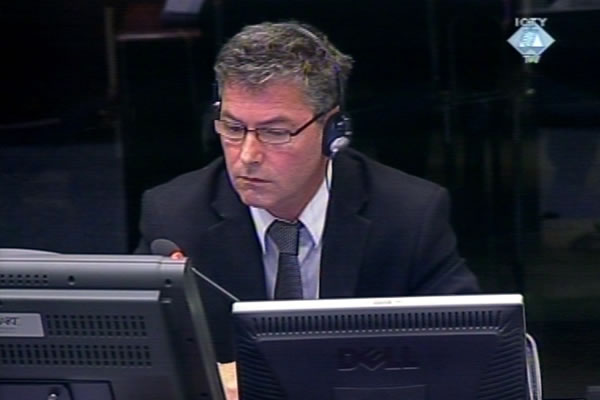Home
RUEZ: ONLY ‘VICTIMS OF EXTERMINATION’ WERE BURIED IN MASS GRAVES
Continuing his cross-examination of the former head of the Srebrenica investigation Jean-Rene Ruez, the accused Karadzic tried to prove that the victims exhumed from mass graves in the Srebrenica area had been soldiers killed in combat, before and in July 1995. The witness countered by saying that a great quantity of evidence, including documents of the VRS Zvornik Brigade seized by the OTP, showed the exact opposite. The mass graves are the result of ‘the extermination of prisoners’, Ruez said
 Jean-Rene Ruez, witness at the Radovan Karadzic trial
Jean-Rene Ruez, witness at the Radovan Karadzic trial The accused Radovan Karadzic continued his cross-examination of French police inspector Jean-Rene Ruez. From 1995 to 2001, Ruez headed the OTP Srebrenica investigation team. Karadzic insisted on his argument that the victims exhumed from mass graves in Podrinje were in fact soldiers of the BH Army 28th Division who had been killed in the attacks on the Serb positions before and during the Srebrenica operation. According to Karadzic, the mass graves were the result of the ‘terrain clear-up operations after combat’. Serb forces were obliged by the law to take the hygiene and sanitation measures.
Karadzic put it to the witness that in the 40 months of war until July 1995, the 28th Division had lost over 2,000 soldiers in the attacks it launched from the enclave on the Serb territory. Karadzic also claimed that a lot of fighters lost their lives as they ‘fought their way towards’ Tuzla in July 1995.
Ruez explained that the Srebrenica investigation didn’t deal with the people who had been killed in combat. ‘We focused on the sites where, according to our information, people were executed on 14, 15 and 16 July 1995’, Ruez said, reminding the accused that a lot of evidence on this issue has already been called through forensic experts Richard Wright and William Haglund. Ruez added that investigator Dean Manning had yet to give evidence. Manning consolidated the findings of all the teams working on the exhumations and established links between detention facilities, execution sites and primary and secondary mass graves. Military analyst Richard Butler dealt with the military aspect of the operation. Ruez also mentioned the documents of the VRS Zvornik Brigade seized by the OTP. The documents made it possible to reconstruct the movement of the military trucks and buses from the sites where the captives were detained for a while to the actual execution sites. The documents also made it possible to follow the movements of the backhoes to the execution sites, where they were used to dig primary graves.
Ruez didn’t want to speculate on the number of people who were in Srebrenica at various points in time from the beginning of the conflict to the fall of the enclave, insisting that the goal of his investigation was to establish what happened to the 8,000 missing men who were on the International Red Cross list. According to that list, a third of the total of 24,000 missing persons in BH was last seen in July 1995 in Srebrenica. More than 6,000 missing persons from Srebrenica have been identified using DNA analysis. Ruez warned that the exhumation and identification process is still ongoing.
Karadzic argued that the massacre in the Kravica warehouse was caused by an incident in which a prisoner grabbed a rifle from a Serb soldier and opened fire. An incident of that kind, even if it had happened, couldn’t explain ‘the systematic killing of all the prisoners’, first in the eastern and then in the western part of the warehouse, Ruez insisted. ‘The killing stopped only when the executioners were sure there were no survivors’, the witness added.
Karadzic put it to Ruez that the number of 1,200 people killed at the Branjevo farm had not been ‘scientifically proven’. The investigators got this information from Drazen Erdemovic who confessed to his part in the executions. Ruez reminded Karadzic that about 1,200 persons were killed at the Branjevo farm and 500 men were executed in Pilica. To ‘scientifically prove’ the number of 1,700 dead would require adding the number of bodies that remained in the primary grave at Branjevo to the number of bodies in nine secondary graves discovered along the Cancari road. The nine graves have not yet been completely exhumed.
Karadzic will continue cross-examining Jean-Rene Ruez tomorrow morning.
Linked Reports
- Case : Karadzic
- 2012-01-31 KARADZIC: MASS GRAVES WERE THE RESULT OF TERRAIN CLEAR-UP
- 2012-01-30 BADLY ELIMINATED TRACES OF CRIME
- 2012-01-27 RECONSTRUCTING THE CRIMES IN SREBRENICA
- 2012-02-02 KARADZIC COUNTS PRISONERS ON AERIAL PHOTOS
- 2012-02-07 LOGISTICS OFFICER FROM 10TH SABOTAGE DETACHMENT TESTIFIES AT KARADZIC TRIAL
- 2012-02-08 KARADZIC’S SECRETARY TESTIFIES
